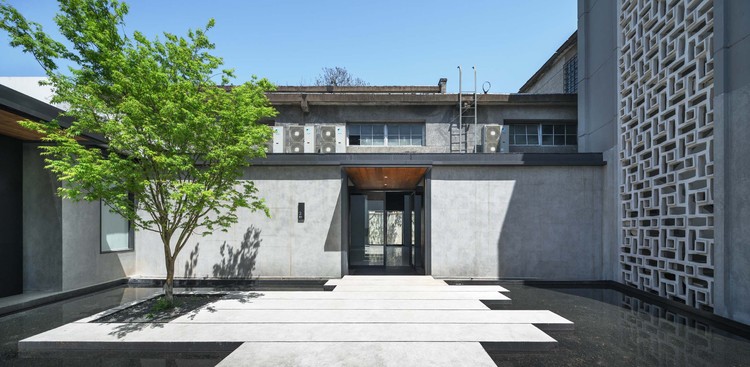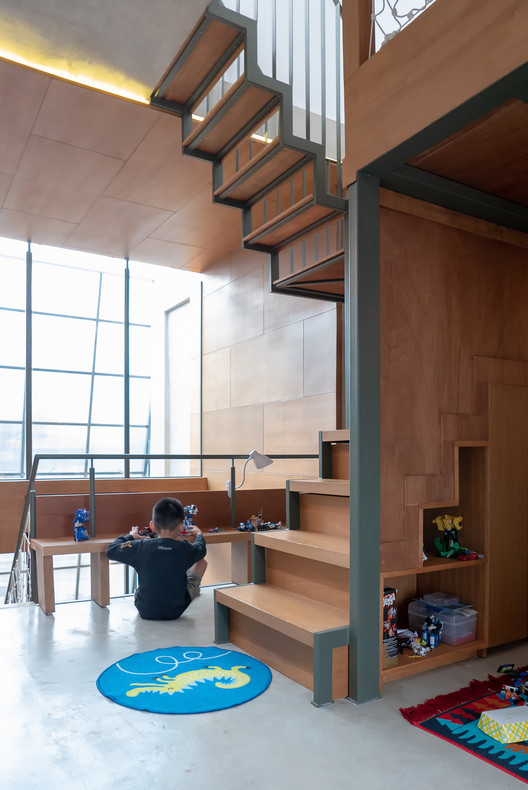Flinders Lane Apartment Clare Cousins Architects
2014-07-18 01:00
架构师提供的文本描述。该项目位于墨尔本CBD的一栋遗产建筑中,为一个年轻家庭重新设想了一套75平方米的公寓。这些客户正期待着他们的第一个孩子,他们的目标是将现有的一居室空间改造成一套适合年轻家庭需要的公寓。
Text description provided by the architects. Located in a heritage-listed building in Melbourne’s CBD, this project reimagines a 75m2 apartment for a young family. The clients, who were expecting their first child, aimed to convert the existing one bedroom space into an apartment suited to the needs of a young family.
传统的日本房屋启发了这两间新的“微型”卧室。第一张只有两米宽,是由一张单人床的长度决定的;第二张是支撑床垫专用床的高平台,用胶合板做茧。滑动屏幕允许房间在视觉上打开,为生活空间提供额外的座位,就像日本人的灵感一样,它可以通过滑动关闭的屏幕转变成一个私人区域。
Traditional Japanese houses inspired the two new ‘micro’ bedrooms. The size of the first, just 2m wide, was determined by the length of a single bed; the second, a raised platform to support the mattress-only bed, is cocooned by plywood. Sliding screens permit the room to be visually open providing additional seating to the living space, and like the Japanese inspiration, it can be transformed to a private zone by sliding the screens closed.
对于Shigeru潘基文的家具之家来说,全高度细木工将微型房间与起居空间隔开,并可从两边进入,为仓库的使用提供了灵活性。夹层阁楼为客人提供了一个睡眠平台,并提供了额外的存储空间。在下面的角落里集成了一个紧凑的工作站。浴室配备了创造性的组成,廉价的瓷砖,和镀金陶器,在这个低调的城市家庭住宅。
A nod to Shigeru Ban’s Furniture House, the full-height joinery separates the micro rooms from the living space and is accessible from both sides, providing flexibility in how the storage is used. A mezzanine loft provides a sleeping platform for guests, and access to additional storage. A compact work station is integrated in the nook below. The bathroom is fitted with creatively composed, inexpensive tiles, and gold electroplated tapware, in this otherwise understated city family dwelling.
Design contribution to the lives of the inhabitants
由于每个人的脚印仅为25平方米,该设计将小公寓的睡眠面积降至最低,并使居住者能享受的生活和社交空间最大化。
With a footprint of just 25m2 per person, the design minimises the sleeping areas of the small apartment and maximises the living and social spaces to be enjoyed by the occupants.
这个家庭有意识地决定扩大现有空间的规划,而不是扩大所需的空间,以适应他们成长中的家庭。靠近公共交通也使得家庭决定不开车生活成为可能。高密度的生活带来了众多的社会、环境和经济利益,而墨尔本附近众多的城市公园、花园和其他公共空间已经取代了他们对传统郊区后院的需求。
This family made a conscious decision to expand the program of an existing space rather than expand the space required to suit their growing family. Proximity to public transport also makes the family’s decision to live without a car possible. High-density living achieves numerous social, environmental and economic benefits while Melbourne’s numerous nearby city parks, gardens and other public spaces have replaced their need for a traditional suburban backyard.
Relationship of the built form to the context of the project
通过有效的空间规划和共同提供的材料的创造性组成,使客户的小空间和适度的预算最大化。
The clients’ small space and modest budget have been maximised by efficient spatial planning and the creative composition of commonly available materials.
新的平面图最大限度地利用了大方的天花板高度,并且精确地定位了每一道细木工墙,以利用四面墙中的三堵原来的窗户。由此产生的光填充起居室提供舒适,通常可以在大得多的房子。
The new floor plan makes the most of generous ceiling heights and precisely locates each of the joinery walls to take advantage of the original windows on three of the four perimeter walls. The resulting light filled living rooms provide amenity commonly found in much larger houses.
全高度细木工将微型房间与起居空间分开,并可从两侧进入,在存储方式上提供了灵活性。
Full-height joinery separates the micro rooms from the living space and is accessible from both sides, providing flexibility in how the storage is used.
这些客户正期待着他们的第一个孩子,他们的目标是将现有的一居室空间改造成一套适合年轻家庭需要的公寓。
The clients, who were expecting their first child, aimed to convert the existing one bedroom space into an apartment suited to the needs of a young family.
第一间只有两米宽的“微型”卧室是由一张单人床的长度决定的;第二间是支撑床垫专用床的高平台,是用胶合板做茧的。滑动屏幕允许房间在视觉上打开,为生活空间提供额外的音量和座位,就像日本人的灵感一样,它可以通过滑动关闭的屏幕转变成一个私人区域。
The first ‘micro’ bedroom, just 2m wide, was determined by the length of a single bed; the second, a raised platform supporting the mattress-only bed, is cocooned by plywood. Sliding screens permit the room to be visually open providing additional volume and seating to the living space, and like the Japanese inspiration, it can be transformed to a private zone by sliding the screens closed.
Integration of allied disciplines
通过与构建者的密切协作,克服了独特的站点限制。在公寓阳台上,采用滑轮系统将胶合板和其他建筑材料吊起,避免了在繁忙的车道上使用昂贵的起重机,也不需要耗费时间的人工来提升传统建筑狭窄的楼梯。
Unique site constraints were overcome through close collaboration with the builder. A pulley system was employed to hoist plywood and other building materials over the apartment’s balcony, avoiding the need for a costly crane in the busy lane, or time consuming manual lifting up the heritage building’s narrow stairs.
胶合板的单一使用不仅提高了对空间的感觉,而且提供了双重的成本效益;胶合板是负担得起和容易获得的,许多细木工被设计成由木匠建造,从而进一步降低了建筑成本。
The singular use of plywood not only enhances the perception of space, but also provides dual cost-benefits; plywood is affordable and readily available, and much of the joinery was designed to be constructed by a carpenter, further minimising construction costs.
该项目表明,紧凑的内城居住和功能家庭住宅不一定是相互排斥的。客户决定留在一个较小的空间,使他们微薄的预算能够通过高效的空间规划和具有创造性的通用材料组合而得到最大限度的利用。
This project demonstrates that compact inner-city living and functional family homes need not be mutually exclusive. The clients’ decision to remain in a small space allowed their modest budget to be maximised by efficient spatial planning and a creative composition of commonly available materials.
整个项目所用材料的减少不仅提高了对空间的认识,而且提供了双重的成本效益;胶合板是负担得起的,而且很容易获得,细木工的设计主要是由木匠建造,从而进一步降低了建筑成本。创造性的组成,廉价的浴室瓷砖是由镀金挂件。
The reduced palette of materials used throughout the project not only enhances the perception of space, but also provides dual cost-benefits; plywood is affordable and readily available and much the joinery was designed to be constructed by a carpenter, further minimising construction costs. Creatively composed inexpensive bathroom tiles are elevated by gold electroplated tapware.
本项目表明,高密度内城居住与现代化、功能性的家庭住宅不一定是相互排斥的。小规模生活的好处在许多方面变得显而易见;家庭住宅的机械加热和冷却仅限于一个房间,而靠近公共交通使家庭决定不使用汽车生活成为可能。
This project demonstrates that high density inner-city living and modern, functional family homes need not be mutually exclusive. The benefits of small scale living become apparent in numerous ways; mechanical heating and cooling of the family home is reduced to little more than a single room, while proximity to public transport makes the family’s decision to live without a car possible.
通过有效的空间规划和共同提供的材料的创造性组成,使客户的小空间和适度的预算最大化。新的平面图最大限度地利用了大方的天花板高度,并且精确地定位了每一道细木工墙,以利用四面墙中的三堵原来的窗户。由此产生的光填充起居室提供舒适,通常可以在大得多的房子。
The clients’ small space and modest budget have been maximised by efficient spatial planning and the creative composition of commonly available materials. The new floor plan makes the most of generous ceiling heights and precisely locates each of the joinery walls to take advantage of the original windows on three of the four perimeter walls. The resulting light filled living rooms provide amenity commonly found in much larger houses.
在我们日益增长的消费文化中,缺乏过多的“东西”让人感到平静和安慰。仔细考虑的存储为每个家庭成员的必需品提供了空间,但限制了消费,并赋予他们选择与之生活的物品更大的价值。
In our increasingly consumer culture, there’s something serene and comforting about a lack of excessive ‘stuff’. Carefully considered storage provides space for each family member’s essentials, yet limits consumption and places greater value on the objects that they have chosen to live with.
100多年前,作为一座商业办公大楼,列入遗产名单的圣经大厦在1997年被改建为小公寓。尽管维多利亚邮编3000计划最早成功的目的是吸引居民到墨尔本的CBD,但低效的空间规划限制了现有一居室公寓的功能和舒适性。
Conceived over 100 years ago as a commercial office building, the heritage listed Bible House building was converted to small apartments in 1997. Although one of the earliest successes of Victoria’s Postcode 3000 program aimed at attracting residents to Melbourne’s CBD, inefficient spatial planning limited both the function and amenity of the existing one bedroom apartment.
为了适应他们成长中的家庭,客户有意识地决定扩大现有的小型住宅项目,而不是迁往郊区较大的低密度住宅。受有空间意识的日本设计的启发,由此产生的家庭住宅有效地满足了所有客户的需求,每个人的足迹仅为25平方米。
To suit their growing family, the clients made the conscious decision to expand the program of the existing small dwelling rather than relocate to larger low-density housing in the suburbs. Inspired by space-conscious Japanese design, the resulting family home efficiently addresses all of the clients’ needs within a footprint of just 25m2 per person.
随着时间的推移,这套公寓内的项目逐渐致密化,这反映了在我们现有的建筑环境中高密度生活的必要性。对现有遗产空间进行敏感调整,以适应其使用者的要求,对于我们市中心的可持续发展至关重要。
The gradual densification of program within this single apartment over time reflects the current necessity for high-density living within our existing built environment. The sensitive adaptation of existing heritage spaces to suit the requirements of their users is fundamental to the sustainable development of our inner city.
Architects Clare Cousins Architects
Location Flinders Lane, Melbourne VIC, Australia
Category Apartment Interiors
Interior Designer Dita Beluli
Graduate Architect Jessie Fowler
Photographs Lisbeth Grosmann
 举报
举报
别默默的看了,快登录帮我评论一下吧!:)
注册
登录
更多评论
相关文章
-

描边风设计中,最容易犯的8种问题分析
2018年走过了四分之一,LOGO设计趋势也清晰了LOGO设计
-

描边风设计中,最容易犯的8种问题分析
2018年走过了四分之一,LOGO设计趋势也清晰了LOGO设计
-

描边风设计中,最容易犯的8种问题分析
2018年走过了四分之一,LOGO设计趋势也清晰了LOGO设计






.jpg)



.jpg)

































.jpg)

.jpg)

























